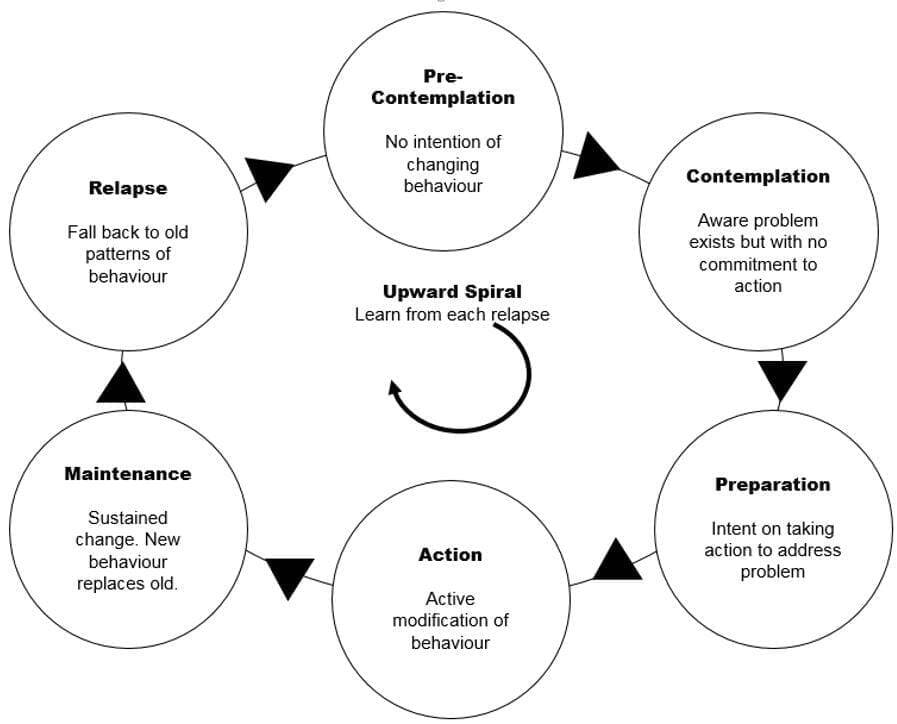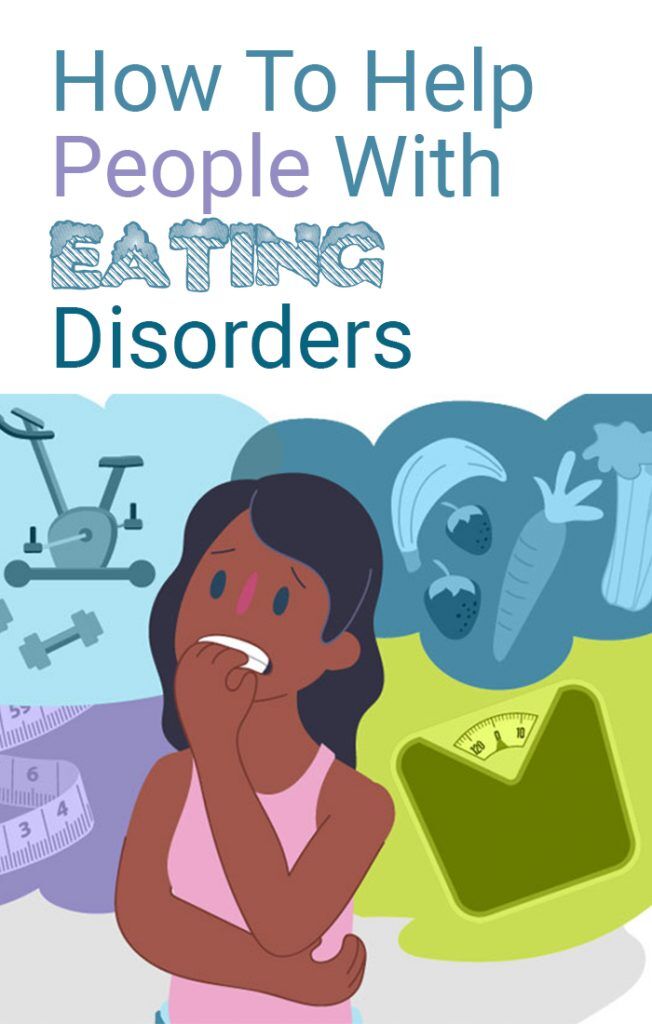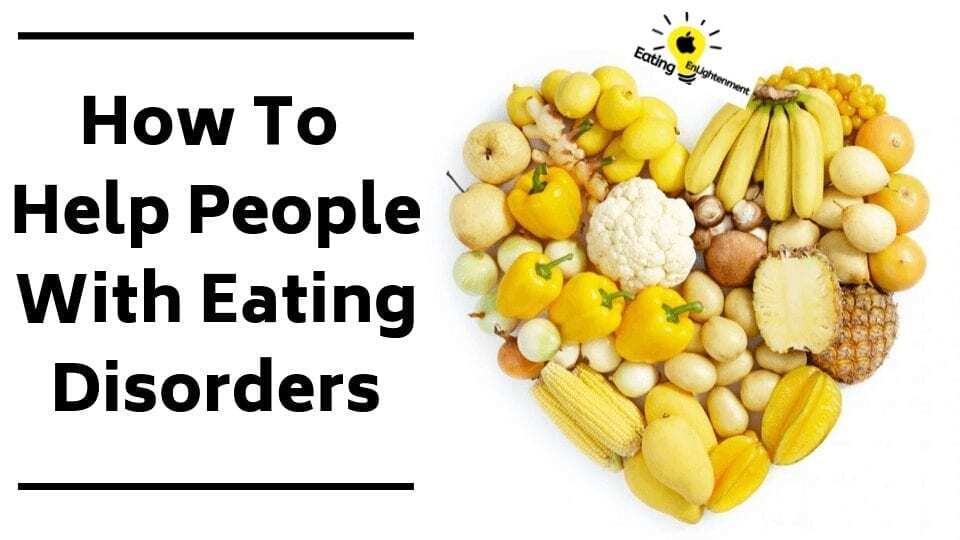Today we continue to learn how to help people with eating disorders.
Specifically today we are focusing on non-threatening exercises.
What’s a nonthreatening exercise?
A nonthreatening exercise is designed for someone in the pre-contemplation stage.
This terminology “pre-contemplation” comes from the “Stages of Change” behavioral change model.

One aspect of this behavior change model is that we recognize people are not ready to change sometimes.
If you have ever tried to convince and alcoholic to stop drinking and were unsuccessful, it’s because this person was in the “precontemplation” or “contemplation” stages.
And the same effect can occur with eating disorders…
Often times people with eating disorders don’t know how to ask for help.
So instead of ‘getting’ someone to change, doing an intervention …
You can use nonthreatening exercises instead.
Now the downside to a nonthreatening exercise is that the person might not take action after you do the exercise. But that’s ok. In this approach we are being patient.
Because hopefully, the person won’t retract either. They’ll be willing to talk with you again. They’ll be more open to ideas that they have resources around them and can get help.
Real quick let me make something very clear:
If a person with an eating disorder goes through the following exercises our goal is NOT for them to take action.
This person is probably not ready to take action just yet. Our goal instead is to simply get the person talking about their struggles.
Once a person is talking about their eating struggles, then you just have to be patient. Be more patient than you ever have in your life.
Don’t give advice. Just keep bringing the person’s attention and memory back to these resource lists which you can create in this nonthreatening exercise.
Remember, this person has a thousand thoughts flying through their head. Really, they simply need a place to feel safe.

Using “Resources Lists” As A Helpful Way To Admit Eating Disorder Struggles
This means that often times you need to give this person resources so they feel more comfortable and secure and opening up about their struggles with food.
Here are three types of resources you can bring up in discussion in a non-threatening way:
1 – Internal Resources – emotional, cognitive, spiritual, relational,psychological, creative, physical
2 – Identify Unhelpful Resources – hyper vigilance, lashing out, running away, shutting down, disconnecting, cutting off from feelings and needs, overeating, working too hard, staying busy, trying to be perfect
3 – External Resources – emotional, relational, cognitive, psychological, material, spiritual
How To Help People With Eating Disorders Context:
Having a conversation about internal and external resources is always pretty safe.
True, you might need to call the person over and have a sit-down chat with the person.
Now normally in the beginning of the conversation there might be some defensiveness. That’s almost unavoidable.
Yet these resource lists are an exercise that are nonthreatening!
Going through these lists will get a person warmed up to seeing how much support they have around them.
As a person gets used to the idea that they are safe, that they will not be teased if they get help, and that they won’t be judged …
Then the person can move from a pre-contemplation stage to an action stage. This is to a gradual conversation tip as to how to help people with eating disorders!
Terminology Of Nonthreatening Resource Exercise
The real usefulness here is exploring the variety of categories both internally and externally.
Down below there is a list of both internal and external resources that can be discussed.
I’d recommend creating a list of these resources so that they are readily accessible in times of darkness.
Before giving the lists about internal external resources, let’s talk about survival strategies.
This terminology is used later on in the exercise.
Survival strategies are ways that are unskilled. They are remnants of our childhood. As children we didn’t know how to sooth ourselves or to take a different perspective. These are one of the reasons why it’s behavior – not sugar addiction – that lead to food addiction.
So, we learned to manage our emotions by perhaps overeating, or lashing out.
The conversation around survival strategies can be tougher. If you do start talking about survival strategies I’d recommend a light, joking tone.
When you use a light tone you might say things like –
“Oh my gosh, just the other day I totally coped with stress at work by eating a whole bag of popcorn! I couldn’t believe it – but at least I enjoyed myself”
The reason a light, non serious approach to survival strategy is important is because we can all admit to ourselves that these strategies don’t work. Yet if we are judged after we admit to ourselves that our survival strategies don’t work, we will shut down.
As long as we aren’t being criticized most people can open up an identify they might be using these strategies even if they are helpful.
So, just simply go through these 3 lists and then come up with a few ideas for each list.
To use these lists just talk with someone (or you can do by yourself) and brainstorm ideas for each category and sub-category.
This alone is a very helpful exercise!
Really though, the key is to have these lists available when you are going through a hard time. Or, if you are learning how to help people with eating disorders, then for this person to have a hard copy available in hard times.
Then, when you are struggling with a difficult emotion, follow these two steps:
STEP 1. Remind your feeling self of a few internal and external resources at your disposal. Notice how you feel when you highlight your resources. Literally read the lists!
STEP 2. Flood your feeling self with hopeful thoughts. Notice how you feel when you practice optimism. Literally read the lists aloud to start flooding your feeling self!
Here are some examples of Internal Resources:
EMOTIONAL
•Access to uplifting emotions (joy, excitement, inspiration, passion)
•Access to calming emotions (contentment, peacefulness, tranquility)
•Emotional endurance — the ability to tolerate unpleasant emotions and move through them
•Ability to identify how emotions present in your body as sensations
•Ability to regulate and manage emotions and sensations and allow them to guide you
•Access to gut senses and intuitive hunches
•Ability to communicate and express emotions
•Ability to perceive others’ emotions and read their body language
•Capacity for experiencing connecting emotions (sympathy, empathy, compassion)
COGNITIVE
•Ability to focus and pay attention
•Ability to understand and comprehend
•Skills to read, study, and learn
•Ability to solve problems and work things out
•Ability to store and retrieve memories
•Capacity for thinking creatively
•Access to intellect and brilliance
RELATIONAL
•Ability to be a team player
•Skill to be cooperative and accommodating
•Ability to value relationships
•Feeling worthy of relationships
•Good conversationalist
•Friendliness
•Playfulness
•Warmth
•Caring
•Love of animals
PSYCHOLOGICAL
•Solid sense of self
•Good self-esteem; confidence
•Sense of competency and mastery
•Even-keeled nature
•Openness
•Flexibility
•Ability to hold hope; optimism
•Resilience
•Tenacity; persistence
•Determination; drive
•Ability to recognize needs
•Skill to assert and drive yourself
•Ability to envision goals; growth oriented
•Ability to delay gratification
•Willingness to be uncomfortable to meet goals
•Ability to set limits and boundaries
•Access to insight, wisdom, and a supportive inner voice
•Sense of humor
•Curiosity
•Courage
SPIRITUAL
•Ability to connect to “higher self” or any form of spiritual guide
•Enjoyment of spiritual or religious, faith-based practices and teachings
•Ability to connect to spiritual energy
•Ability to follow wisdom practices
•Uplifting sense of awe in nature
•Clairvoyance or transpersonal capacities
CREATIVE
•Access to the creative process through acting, beading, building, crafts, cooking, dance, decorating, design, drawing, gardening, making jewelry, knitting, music, needlepoint, poetry, quilting, sewing, sculpting, visual arts, writing, or any other creative pursuits
PHYSICAL
•Sturdy constitution
•Good health
•Productivity
•Industriousness
•High energy
•Good endurance
•Fitness — strong and toned muscles, strength, and flexibility
•Beauty or handsomeness
•Ability to connect with your body and pay attention to sensations and senses
•Enjoyment of sensual and sexual activities
•Capacities such as playing sports, dancing, running, walking, hiking, swimming, and climbing
Here are some examples of Survival Resources:
COPING WITH DIFFICULT CAREGIVERS
•Ability to predict caregivers’ moods and behaviors
•Ability to discern caregivers’ needs
•Skill to please and accommodate caregivers
•Ability to take care of caregivers and other family members
•Hypervigilance: looking out for abusive behavior
•Lashing out or acting out
•Throwing tantrums
•Getting into trouble
•Staying away
•Running away
•Using aggression and violence
SHUTTING DOWN
•Escaping into books, music, art, activities, fantasy, and so on
•Withdrawing or isolating
•Creating imaginary friends
•Avoiding contact
•Cutting off from feelings and needs
•Hiding aspects of yourself
•Using drugs or alcohol
•Overeating, undereating, or stopping eating
•Oversleeping
•Harming your body
•Disconnecting from yourself (dissociation)
EXCELLING AND OVERDOING
•Getting good grades
•Taking on leadership roles
•Being a superstar in the family
•Staying busy
•Trying to be perfect
•Being a know-it-all
•Taking on many extracurricular activities
•Driving yourself hard
•Focusing on externals: looks, things, money, accomplishments, and so on •Getting attention for excelling at various activities
Here are some examples of External Resources:
EMOTIONAL
•Family and friends
•Life partner
•Companion animals
•Journaling; therapy
•Movies, television, books, and music
•Podcasts and videos
•Hot baths
•Comfortable clothing
•Comfortable places
RELATIONAL
•Family and friends
•Life partner
•Companion animals
•Neighbors
•Colleagues
•Support groups
•Paid professionals (but be careful)
•Community members
•Group activities
•Activity buddies
COGNITIVE
•Classes, lessons
•Libraries
•Study groups
•Books and audio courses
•Online programs
•Games and puzzles
•Educational television
•Radio programs
PSYCHOLOGICAL
•Therapy, counseling, and coaching
•Seminars and workshops
•Books and workbooks
•Support groups
•Community programs
•Online programs
•Nature
MATERIAL
•Sources of income: job or investments
•Financial support
•A home
•Appliances and tools
•A car or alternative transportation
•Clothing
•Material goods
•Grocery stores and restaurants
SPIRITUAL
•Spiritual community and facilities
•Religious or spiritual mentors
•Spiritual instruction and guidance
•Ceremonies and rituals
•Spiritual books and recordings
CREATIVE
•Art and craft supplies and tools
•Cooking and baking supplies and tools
•Musical instruments
•Computers, MP3 and DVD players
•Classes, lessons, and groups
•Creative companions
•Community facilities
•Museums and galleries
•Theaters
Please note these nonthreatening exercises will not solve the overall problem of eating disorders. Of course not. But they can get you started.





